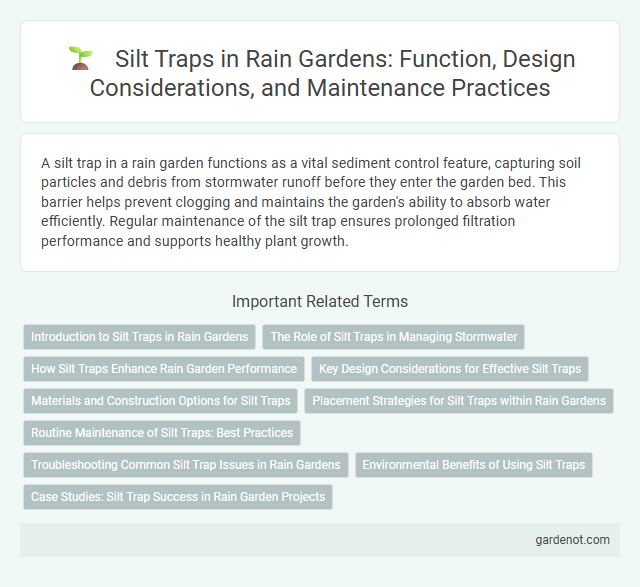A silt trap in a rain garden functions as a vital sediment control feature, capturing soil particles and debris from stormwater runoff before they enter the garden bed. This barrier helps prevent clogging and maintains the garden's ability to absorb water efficiently. Regular maintenance of the silt trap ensures prolonged filtration performance and supports healthy plant growth.
Introduction to Silt Traps in Rain Gardens
Silt traps in rain gardens function as essential sediment control features that capture and prevent silt and debris from entering the main planting areas. These traps enhance water quality by filtering out particulates, reducing soil erosion, and promoting healthier plant growth. Properly designed silt traps improve rain garden efficiency by maintaining infiltration rates and protecting downstream ecosystems from sediment pollution.
The Role of Silt Traps in Managing Stormwater
Silt traps play a crucial role in managing stormwater by capturing sediment and preventing soil erosion within rain gardens. By filtering out silt and debris, they protect the integrity of the rain garden's soil structure and promote water infiltration. Effective silt trap installation enhances stormwater quality and reduces downstream pollution in urban drainage systems.
How Silt Traps Enhance Rain Garden Performance
Silt traps improve rain garden performance by capturing sediment before it enters the garden, preventing clogging and maintaining soil permeability. By reducing sediment buildup, silt traps promote better water infiltration and protect plant roots from suffocation. Their strategic placement enhances stormwater management and extends the lifespan of rain gardens.
Key Design Considerations for Effective Silt Traps
Effective silt traps in rain gardens require careful sizing to capture sediment without impeding water flow, ensuring sediment settles before reaching plants. Incorporating easily accessible maintenance features, such as removable sediment basins or inspection ports, allows for regular cleaning and prolongs trap functionality. Selecting durable, erosion-resistant materials and strategically placing the silt trap at the garden's inflow optimizes sediment capture and protects downstream ecosystems.
Materials and Construction Options for Silt Traps
Silt traps in rain gardens are typically constructed using durable materials such as perforated PVC pipes, gravel, and geotextile fabric to effectively capture and filter sediment. Common construction options include installing outlet structures with sediment basins or basins lined with crushed stone to slow water flow and enhance sediment deposition. Proper sizing and placement ensure efficient sediment retention, reducing downstream pollution and maintaining rain garden functionality.
Placement Strategies for Silt Traps within Rain Gardens
Effective placement of silt traps within rain gardens involves situating them at inflow points where runoff enters the garden to maximize sediment capture. Positioning silt traps upstream of vegetation zones prevents sediment accumulation that could choke plant roots and disrupt filtration. Ensuring accessibility for routine maintenance enhances sediment removal efficiency and prolongs rain garden functionality.
Routine Maintenance of Silt Traps: Best Practices
Routine maintenance of silt traps in rain gardens involves regular inspection to remove accumulated sediment and debris, ensuring optimal water flow and filtration. Employing manual or mechanical cleaning methods helps prevent clogging and maintains the trap's effectiveness in controlling soil erosion. Establishing a maintenance schedule based on local rainfall patterns and sediment load improves long-term performance and supports the rain garden's overall ecological function.
Troubleshooting Common Silt Trap Issues in Rain Gardens
Silt traps in rain gardens commonly face clogging due to excessive sediment buildup, which hampers water infiltration and causes overflow. Regular inspection and removal of trapped silt are essential to maintain proper drainage and prevent damage to plant roots. Using a layered design with mulch and gravel can reduce sediment accumulation and improve silt trap efficiency.
Environmental Benefits of Using Silt Traps
Silt traps play a crucial role in rain gardens by capturing sediment and preventing it from entering waterways, thereby reducing water pollution and protecting aquatic ecosystems. These traps enhance soil stability, which minimizes erosion and promotes healthier plant growth within the rain garden. By filtering out silt and debris, silt traps contribute to improved water quality and support sustainable stormwater management practices.
Case Studies: Silt Trap Success in Rain Garden Projects
Rain garden projects incorporating silt traps have demonstrated significant improvements in sediment control, as seen in the Chesapeake Bay restoration efforts where sediment reduction exceeded 40%. Studies from the Puget Sound region reveal that silt traps within rain gardens effectively prevent soil erosion and protect water quality by capturing up to 75% of suspended sediments. These case studies highlight silt traps as essential components in enhancing rain garden performance for urban stormwater management.
Silt trap Infographic

 gardenot.com
gardenot.com